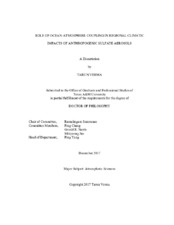| dc.description.abstract | Using a suite of coupled and uncoupled climate model experiments, we explore the
impacts of anthropogenic sulfate aerosols on tropical Pacific climate and its variability.
The role of sea surface temperature (SST), ocean dynamics, and ocean-atmosphere
interaction in climate response to aerosols is examined by appropriately choosing the
ocean component namely, full ocean general circulation model (OGCM), slab ocean
model (SOM) or prescribed climatological SST. The ensemble of shorter responses
versus a long-term response highlights processes and coupled feedbacks that are active
on seasonal-interannual timescales versus on multi-decadal timescales. We find that an
abrupt increase in tropospheric sulfate aerosols gives rise to El Niño like warming of the
eastern tropical Pacific on seasonal-interannual timescales. Dynamical interaction
between the ocean and the atmosphere causes this equatorial warming, whereas the
thermodynamic interaction is responsible for the off-equatorial warming. These two
interactions are related to the presence of Bjerknes feedback over the equator versus the
off-equatorial WES (Wind-Evaporation-SST) feedback in the tropical climate system. In
long-term, ocean dynamics will remove the initial tropical warming leaving a weaker
and negative SST in response to increased aerosols in the fully-coupled case. Absence of
ocean dynamics in the partially-coupled case, on the other hand, will lead to
amplification of the off-equatorial warming via positive WES feedback. These coupled
feedbacks, therefore, control the intertropical convergence zone (ITCZ) shift in response
to aerosols over the eastern tropical Pacific. In this study, we also identify a cloud microphysics based mechanism for the high cloud increase over the tropical Indian
Ocean. This regional increase in high clouds results in local net positive radiative
forcing in comparison to negative forcing elsewhere on the globe. | en |


